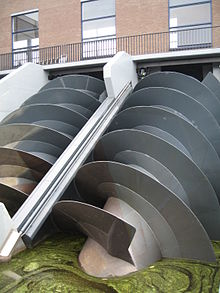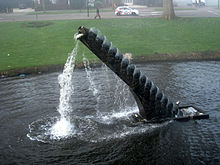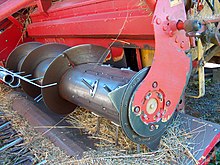Archimedes' screw


The Archimedes' screw, also known as the Archimedean screw, hydrodynamic screw, water screw or Egyptian screw,[1] is one of the earliest hydraulic machines named after Greek mathematician Archimedes who first described it around 234 BC, although the device had been used in Ancient Egypt.[2] It is a reversible hydraulic machine, and there are several examples of Archimedes screw installations where the screw can operate at different times as either pump or generator, depending on needs for power and watercourse flow.
As a machine used for lifting water from a low-lying body of water into irrigation ditches, water is lifted by turning a screw-shaped surface inside a pipe. In the modern world, Archimedes screw pumps are widely used in wastewater treatment plants and for dewatering low-lying regions. Run in reverse, Archimedes screw turbines act as a new form of small hydroelectric powerplant that can be applied even in low head sites. Such generators operate in a wide range of flows (0.01 to 14.5 ) and heads (0.1 m to 10 m), including low heads and moderate flow rates that is not ideal for traditional turbines and not occupied by high performance technologies.
History
[edit]
Earliest records
[edit]The screw pump is the oldest positive displacement pump.[1] The first records of a water screw, or screw pump, date back to Ancient Egypt before the 3rd century BC.[1][3] The Egyptian screw, used to lift water from the Nile, was composed of tubes wound round a cylinder; as the entire unit rotates, water is lifted within the spiral tube to the higher elevation. A later screw pump design from Egypt had a spiral groove cut on the outside of a solid wooden cylinder and then the cylinder was covered by boards or sheets of metal closely covering the surfaces between the grooves.[1]
Some researchers have proposed this device was used to irrigate the Hanging Gardens of Babylon, one of the Seven Wonders of the Ancient World. A cuneiform inscription of Assyrian King Sennacherib (704–681 BC) has been interpreted by Stephanie Dalley[4] to describe casting water screws in bronze some 350 years earlier. This is consistent with Greek historian Strabo, who describes the Hanging Gardens as irrigated by screws.[5]
Archimedes role
[edit]The screw pump was later introduced from Ancient Egypt to Greece.[1] It was described by Archimedes,[6] on the occasion of his visit to Egypt, circa 234 BC.[7] This tradition may reflect only that the apparatus was unknown to the Greeks before Hellenistic times.[6] Athenaeus of Naucratis quotes a certain Moschion in a description on how Hiero II of Syracuse commissioned the design of the Syracusia, a luxury ship which would be a display of naval power.[8] It is said to have been the largest ship built in classical antiquity and was launched by Archimedes who designed device with a revolving screw-shaped blade inside a cylinder to remove any potential water leaking through the hull.[9] Archimedes' screw was turned by hand, and could also be used to transfer water from a low-lying body of water into irrigation canals.[10][11]
Archimedes never claimed credit for its invention, but it was attributed to him 200 years later by Diodorus, who believed that Archimedes invented the screw pump in Egypt.[1] Depictions of Greek and Roman water screws show them being powered by a human treading on the outer casing to turn the entire apparatus as one piece, which would require that the casing be rigidly attached to the screw.
Development and modern use
[edit]German engineer Konrad Kyeser equipped the Archimedes screw with a crank mechanism in his Bellifortis (1405). This mechanism quickly replaced the ancient practice of working the pipe by treading.[12] The world's first seagoing steamship driven by a screw propeller was the SS Archimedes, which was launched in 1839 and named in honor of Archimedes and his work on the screw.[13] Developments in maritime transport occurred over the next 180 years from the Fawcett, Preston and Company double blade design and patents by Sharrow Marine to address rotary propulsion and flow control on boating vessels through loop propellers. Electricity generation through hydropower pumps such as the Meriden project operated by New England Hydropower also uses Archimedes screw to direct water into the top, rather than the bottom, of the screw which forces it to rotate.[14][15]


Archimedes screws are used in sewage treatment plants because they cope well with varying rates of flow and with suspended solids.[16] Screw turbines (ASTs) are a new form of generator for small hydroelectric powerplants that could be applied even in low-head sites. The low rotation speed of ASTs reduces negative impacts on aquatic life and fish. This technology is used primarily at fish hatcheries to lift fish safely from ponds and transport them to another location. An Archimedes screw was used in the successful 2001 stabilization of the Leaning Tower of Pisa. Small amounts of subsoil saturated by groundwater were removed from far below the north side of the tower, and the weight of the tower itself corrected the lean.
Other inventions using Archimedes screws include the auger conveyor in a snow blower, grain elevator, concrete mixer and chocolate fountain.
Design
[edit]The Archimedes screw consists of a screw (a helical surface surrounding a central cylindrical shaft) inside a hollow pipe. The screw is usually turned by windmill, manual labor, cattle, or by modern means, such as a motor. As the shaft turns, the bottom end scoops up a volume of water. This water is then pushed up the tube by the rotating helicoid until it pours out from the top of the tube.
The contact surface between the screw and the pipe does not need to be perfectly watertight, as long as the amount of water being scooped with each turn is large compared to the amount of water leaking out of each section of the screw per turn. If water from one section leaks into the next lower one, it will be transferred upwards by the next segment of the screw.
In some designs, the screw is fused to the casing and they both rotate together, instead of the screw turning within a stationary casing. The screw could be sealed to the casing with pitch resin or other adhesive, or the screw and casing could be cast together as a single piece in bronze.
The design of the everyday Greek and Roman water screw, in contrast to the heavy bronze device of Sennacherib, with its problematic drive chains, has a powerful simplicity. A double or triple helix was built of wood strips (or occasionally bronze sheeting) around a heavy wooden pole. A cylinder was built around the helices using long, narrow boards fastened to their periphery and waterproofed with pitch.[5]
Studies show that the volume of flow passes through Archimedes screws is a function of inlet depth, diameter and rotation speed of the screw. Therefore, the following analytical equation could be used to design Archimedes screws:
where is in and:
: Rotation speed of the Archimedes screw (rad/s)
: Volumetric flow rate
Based on the common standards that the Archimedes screw designers use this analytical equation could be simplified as:[17]
The value of η could simply determinate using the graph or graph.[17] By determination of , other design parameters of Archimedes screws can be calculated using a step-by-step analytical method.
Variants
[edit]
A screw conveyor is a similar device which transports bulk materials such as powders and cereal grains. It is contained within a tube and turned by a motor to deliver material from one end of the conveyor to the other and particularly suitable for transport of granular materials such as plastic granules used in injection moulding. It may also be used to transport liquids. In industrial control applications, the conveyor may be used as a rotary feeder or variable rate feeder to deliver a measured rate or quantity of material into a process.
A variant of the Archimedes screw can also be found in some injection moulding machines, die casting machines and extrusion of plastics, which employ a screw of decreasing pitch to compress and melt the material. It is also used in a rotary-screw air compressor. On a much larger scale, Archimedes's screws of decreasing pitch are used for the compaction of waste material.
Reverse action
[edit]If water is fed into the top of an Archimedes screw, it will force the screw to rotate. The rotating shaft can then be used to drive an electric generator. Such an installation has the same benefits as using the screw for pumping: the ability to handle very dirty water and widely varying rates of flow at high efficiency. Settle Hydro and Torrs Hydro are two reverse screw micro hydro schemes operating in England. The screw works well as a generator at low heads, commonly found in English rivers, including the Thames, powering Windsor Castle.[18]
See also
[edit]- Archimedean spiral
- Screw-propelled vehicle
- Screw (simple machine)
- Spiral pump
- Toroidal propeller
- Vitruvius
Notes
[edit]- ^ a b c d e f Stewart, Bobby Alton; Terry A. Howell (2003). Encyclopedia of water science. USA: CRC Press. p. 759. ISBN 0-8247-0948-9.
- ^ New Standard Encyclopedia. Standard Educational Corp. 1978. p. A-257. ISBN 9780873921831. Retrieved 30 April 2020.
The Archimedes' screw was developed in ancient Egypt and was subsequently used by Archimedes (287–212 b.c.)
- ^ "Screw". Encyclopædia Britannica online. The Encyclopaedia Britannica Co. 2011. Retrieved 2011-03-24.
- ^ Stephanie Dalley, The Mystery of the Hanging Garden of Babylon: an elusive World Wonder traced, (2013), OUP ISBN 978-0-19-966226-5
- ^ a b Dalley, Stephanie; Oleson, John Peter (2003). "Sennacherib, Archimedes, and the Water Screw: The Context of Invention in the Ancient World". Technology and Culture. 44 (1): 1–26. doi:10.1353/tech.2003.0011. S2CID 110119248.
- ^ a b Oleson 2000, pp. 242–251
- ^ Haven, Kendall F. (2006). One hundred greatest science inventions of all time. USA: Libraries Unlimited. pp. 6–. ISBN 1-59158-264-4.
- ^ Casson, Lionel (1971). Ships and Seamanship in the Ancient World. Princeton University Press. ISBN 978-0-691-03536-9.
- ^ "Athenaeus, The Deipnosophists, BOOK V., chapter 40". www.perseus.tufts.edu. Archived from the original on 15 March 2023. Retrieved 7 March 2023.
- ^ Dalley, Stephanie; Oleson, John Peter. "Sennacherib, Archimedes, and the Water Screw: The Context of Invention in the Ancient World". Technology and Culture Volume 44, Number 1, January 2003 (PDF). Archived from the original on 16 July 2015. Retrieved 23 July 2007.
- ^ Rorres, Chris. "Archimedes' screw – Optimal Design". Courant Institute of Mathematical Sciences. Archived from the original on 22 July 2012. Retrieved 23 July 2007.
- ^ White 1962, pp. 105, 111, 168
- ^ "SS Archimedes". wrecksite.eu. Archived from the original on 2 October 2011. Retrieved 22 January 2011.
- ^ HLADKY, GREGORY B. "Archimedes Screw Being Used To Generate Power At Meriden Dam". courant.com. Retrieved 2017-08-01.
- ^ "Meriden power plant uses Archimedes Screw Turbine". Retrieved 2017-08-01.
- ^ Ben Finio (July 11, 2019). "Lift Water with an Archimedes Screw". Scientific American.
- ^ a b YoosefDoost, Arash; Lubitz, William David (December 2021). "Design Guideline for Hydropower Plants Using One or Multiple Archimedes Screws". Processes. 9 (12): 2128. doi:10.3390/pr9122128.
- ^ BBC. "Windsor Castle water turbine installed on River Thames" bbc.com, 20 September 2011. Retrieved: 19 October 2017.
Sources
[edit]- P. J. Kantert: "Manual for Archimedean Screw Pump", Hirthammer Verlag 2008, ISBN 978-3-88721-896-6.
- P. J. Kantert: "Praxishandbuch Schneckenpumpe", Hirthammer Verlag 2008, ISBN 978-3-88721-202-5.
- P. J. Kantert: "Praxishandbuch Schneckenpumpe" - 2nd edition 2020, DWA, ISBN 978-3-88721-888-1.
- Oleson, John Peter (1984), Greek and Roman mechanical water-lifting devices. The History of a Technology, Dordrecht: D. Reidel, ISBN 90-277-1693-5
- Oleson, John Peter (2000), "Water-Lifting", in Wikander, Örjan (ed.), Handbook of Ancient Water Technology, Technology and Change in History, vol. 2, Leiden, pp. 217–302 (242–251), ISBN 90-04-11123-9
{{citation}}: CS1 maint: location missing publisher (link) - Nuernbergk, D. and Rorres C.: „An Analytical Model for the Water Inflow of an Archimedes Screw Used in Hydropower Generation", ASCE Journal of Hydraulic Engineering, Published: 23 July 2012
- Nuernbergk D. M.: "Wasserkraftschnecken – Berechnung und optimaler Entwurf von archimedischen Schnecken als Wasserkraftmaschine", Verlag Moritz Schäfer, Detmold, 1. Edition. 2012, 272 papes, ISBN 978-3-87696-136-1
- Rorres C.: "The turn of the Screw: Optimum design of an Archimedes Screw", ASCE Journal of Hydraulic Engineering, Volume 126, Number 1, Jan.2000, pp. 72–80
- Nagel, G.; Radlik, K.: Wasserförderschnecken – Planung, Bau und Betrieb von Wasserhebeanlagen; Udo Pfriemer Buchverlag in der Bauverlag GmbH, Wiesbaden, Berlin (1988)
- White, Lynn Jr. (1962), Medieval Technology and Social Change, Oxford: At the Clarendon Press
External links
[edit]- The Turn of the Screw: Optimal Design of an Archimedes Screw, by Chris Rorres, PhD.
- "Archimedean Screw" by Sándor Kabai, Wolfram Demonstrations Project, 2007.
- "Archimedes Screw Examples Various sources, 2021


![{\displaystyle D_{O}={\sqrt[{3}]{\frac {16\pi Q}{\sigma \omega (2\theta _{O}-sin2\theta _{O}-\delta ^{2}(2\theta _{i}-sin(2\theta _{i}))}}}}](https://wikimedia.org/api/rest_v1/media/math/render/svg/0944d6dd956206bbc71fc80861d6db2f3f7214c1)








